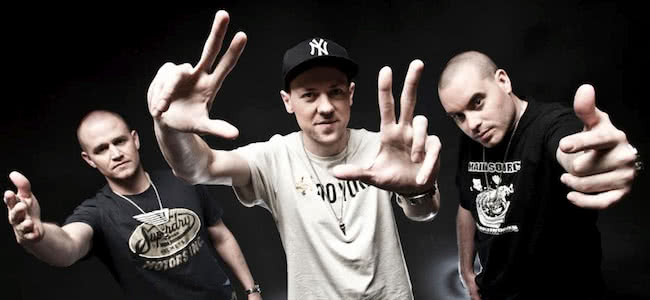Whether you love it or hate it, the status of Aussie hip hop in today’s pop culture landscape is undeniable.
Against the odds, the genre has risen to become a primary force in Australian music. Legions of loyal fans, platinum albums, number one singles, sell-out shows…however you choose to measure success in music, it ticks all the boxes.
Yet, a little bewilderingly, despite the fact artists like Drapht and Bliss n Eso are topping the charts, and 360 and Illy are selling out tours across the country, it wasn’t even 10 years ago that the first Aussie hip hop album broke the mainstream – the Hilltop Hoods’ platinum-selling The Calling in 2003.
So what exactly is Aussie hip hop? Why has it become so popular so quickly? And why do people feel so passionately about it – both for and against?
At first glance the answer may seem simple – Aussie hip hop is hip hop that comes from Australia. But for the most part, it has a completely different sound to its international counterparts. Listen to a classic American hip hop song (one by Jay-Z, for example,) and then listen to someone like Melbourne’s Pez, and you could be forgiven for thinking you were listening to two entirely different genres.
For some, this is the end of the story. Aussie hip hop is not real hip hop, put Dr. Dre back on please. For others, Aussie hip hop is the only real hip hop, and Dr. Dre can get fucked. Both views are alarmingly common, and both are shortsighted.
Aussie hip hop wouldn’t exist without it’s American parentage, and much of American hip hop is obviously nothing short of spectacular. But while it may have been born of Public Enemy and Run DMC, the Australian variety has since gone through its troubled adolescence, struggled to find its independent voice, and has proved itself more than capable of surviving on its own.
It has become its own cultural force, one that is uniquely Australian, and an important part of our music scene today. To find out why, we take a look back at its short, but rich, history.
Hip hop was created in the South Bronx, New York, around forty years ago – but as with seemingly everything else in the world, it took a while for Australia to catch on. The new style (born from DJ Kool Herc playing two copies of the same record at different times on different turntables,) did eventually manage to cross the pacific however, and in the early ‘90s rhymes could be heard in the broader accents of Australian acts such as Melbourne’s Bias B and Western Sydney’s Def Wish Cast.
For the first ten years of its growth, it remained very much a niche genre. While beloved to a rich community of graffiti-ing, b-boying, DJ-ing fans and artists across the country, it continued to be for the most part unknown to mainstream audiences.
The scene thrived underground during this period, culminating in the landmark compilation CDs Obesecity and Culture of Kings I, II and III being released in the early ‘00s by Obese Records. Not only were these albums among the first to recognise there was a wealth of rhyming talent scattered across the country, (as well as a market to buy into it,) they were also a tantalising hint of things to come, with artists such as the Hilltop Hoods and Koolism making up the tracklist.
The transformation of Obese from a small record store in Melbourne’s Prahran to Australia’s first hip hop label was an important step for the development of the genre – especially when they decided to release an album by an up-and-coming group of two MCs and a DJ from the suburbs of Adelaide.
The Calling was the Hilltop Hoods’ third release, but it was their first to break into the mainstream. The album went platinum, and produced what remains to be arguably the Aussie hip hop anthem, ‘The Nosebleed Section’.
This song, with its jubilant flute sample and crowd-loving theme, was embraced by the public, and marked a turning point for the popularity of the scene. In 2009’s Triple J Hottest 100 of All Time, ‘The Nosebleed Section’ was the highest Australian song, highest hip hop song, and the highest song from the 21st century on the list, coming in at #17.
Also released in 2003 was the Herd’s An Elefant Never Forgets, with its highly political single ‘77%.’ The number in the title refers to a survey that found that 77% of Australians supported John Howard’s decision to turn around the Tampa, a Norwegian boat carrying refugees seeking asylum in Australia, which lead to the Pacific Solution being introduced.
The song is highly critical of the move, declaring, “77% of Aussies are racist.” It reached #46 on the Triple J Hottest 100 of 2003, and marked the beginning of the Herd’s strong liberal political voice, capped with 2008’s ‘the King is Dead.’
2004 saw the breakthrough of another 2 MC + DJ combo, from Maroubra, Sydney. Bliss n Eso’s Flowers in the Pavement introduced their characteristic style of heartfelt sincerity with tracks like ‘Watchdog Water Dragons’ sitting neatly beside raucous party anthems such as ‘Pigs in the Porn Trough.’
That year was also the first year the genre was recognised with the “best urban release” category as part the ARIA awards, with Koolism’s Random Thoughts taking out the inaugural accolade.
While the introduction of the “best urban release” category was undoubtedly a positive step for Aussie hip hop, eight years on the consensus remains to be that the recording industry has been slow on the uptake in recognising its importance.
Drapht, winner of the award in 2011, voiced the opinion of many when he said that it was time hip hop was given its own category, beyond the broad “urban” umbrella. More supportive than the industry officials however has been Triple J, who have frequently chosen hip hop releases as their feature albums (such as last week’s This Was Tomorrow, Seth Sentry’s debut,) supported new artists through Unearthed, and have a show dedicated specifically to the genre with ‘the Hip Hop Show.’
2006 saw follow-up albums from the two most successful artists up to this point, Hilltop Hoods’ The Hard Road and Bliss n Eso’s Day of the Dog. The Hard Road especially was critically acclaimed, receiving the ARIA best independent release and best urban release, AIR best independent hip hop/urban release and Triple J’s album of the year.
Closely tied to the success of Aussie hip hop are the record labels aligned to it, who are responsible for promoting new acts, as well as the genre as a whole. Hip hop in Australia has developed without the support of major labels, finding distribution through specialised record companies such as Obese, Elefant Traks, Golden Era Records, and Illusive. Elefant Traks, based in Sydney, has been especially instrumental in the rise of the scene.
It started in 1998, and initially consisted of the artists that would become part of the Herd, such as Urthboy and Ozi Batla. Since then it has signed such quality performers as Horrorshow, Hermitude, and Sky’High.
Golden Era Records was founded in 2009 by the Hilltop Hoods, who left Obese in order to handle their own work. They took with them the Funkoars, and were soon to sign artists such as Vents, Adfu and Briggs. The move also contributed to cementing Adelaide as a hub of Aussie hip hop, with the majority of the acts being part of the Certified Wise Crew – 16 South Australian artists who feature heavily in each others work.
One of the most exciting trends to develop has been the growth of indigenous artists like the Last Kinection, Yung Warriors and Jimblah, who bring a unique voice to the middle-class-white-boy dominated scene.
Songs like ‘Are We There Yet?’ draw attention to the inequality between white and aboriginal Australians; “statistics show that I won’t make the average life expectancy/as the average Aussie that grew up next door to me.” Hip hop started out as the voice of a group that didn’t have a say in the public forum, in the ghettoes of New York – here it is being used for its original purpose, feeding social criticism to the masses.
Recent years have seen a slew of popular singles: Pez’s ‘the Festival Song,’ Drapht’s ‘Jimmy Recard,’ Seth Sentry’s ‘the Waitress Song.’ These days it has become the norm for Aussie hip hop albums to top the ARIA charts – Bliss n Eso’s Running on Air in 2010, Drapht’s The Life of Riley last year.
The debut full-length album Falling and Flying, from Australia’s most polarising hip hop artist, 360, went platinum, as did the Hilltop Hoods’ Drinking From the Sun. 2011 also saw the formation of the first festival to only feature Aussie hip hop, Sprung, in Brisbane.
Next year will mark the 10-year anniversary of The Calling. It’s a little astonishing taking stock of all the scene has achieved in a mere ten years – something the Hilltop Hoods themselves paid homage to in the recent release of their video clip for ‘Rattling The Keys To The Kingdom,’ which celebrates the diversity of the genre by featuring pretty much everyone in Aussie hip hop right now.
So why has it become so popular?
While it may be an offshoot of an American creation, Aussie hip hop is fiercely Australian, with its roots firmly planted in our capital cities and regional areas.
It resonates because of the relevance of so many of its themes to the audience it specifically targets – Aussie pride, partying, smoking weed, political commentary, relationships…broad topics, yes, but subjects virtually everyone can relate to in this country, and that is its strength.
It doesn’t pretend to be something that it isn’t. It’s people you can imagine meeting at the local, rambling about the same shit you talk about with your friends, but with some incredible rhymes and over an amazing beat (M-Phazes we’re looking at you.) It makes you nod you head and it probably makes you laugh in parts.
If you insist on comparing it endlessly to what’s being produced overseas, you probably won’t like it, because it’s completely different. It is its own category, and rightly so. But its uniqueness, especially in comparison to other kinds of hip hop, is what’s responsible for the enthusiastic reaction from people in this country, and it’s what will see it continue to grow and diversify in the coming years.
We can’t wait to see what’s next.

































